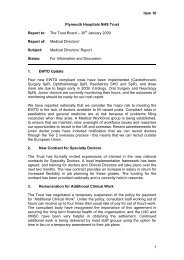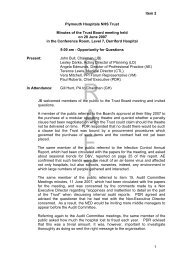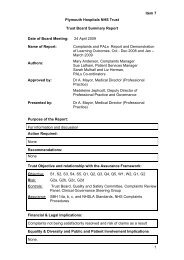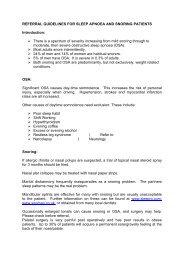Skin Cancer Service - Plymouth Hospitals
Skin Cancer Service - Plymouth Hospitals
Skin Cancer Service - Plymouth Hospitals
You also want an ePaper? Increase the reach of your titles
YUMPU automatically turns print PDFs into web optimized ePapers that Google loves.
<strong>Plymouth</strong> Hospital NHS Trust<br />
<strong>Skin</strong> Grafts for <strong>Skin</strong> <strong>Cancer</strong><br />
<strong>Skin</strong> <strong>Cancer</strong> <strong>Service</strong><br />
Your Hospital Team<br />
Surgery for skin cancer involves removing the affected area and<br />
some of the surrounding, healthy-looking skin. If the area is<br />
fairly small, it will be possible to close the wound by bringing the<br />
edges of the skin together. Larger wounds may need a skin graft<br />
to cover the area.<br />
<strong>Skin</strong> grafts are layers of skin taken from another part of the body<br />
(see the ‘donor site’ leaflet) and placed over the area where the<br />
cancer has been removed. A partial thickness (or split thickness)<br />
skin graft is where the epidermis and a part of the dermis layer is<br />
used. The skin is usually taken from the thigh, buttock or upper<br />
arm. <strong>Skin</strong> will grow back in this area.<br />
A full thickness skin graft is where the epidermis and the full<br />
dermis layers are used. In this case, only a small area is taken<br />
from the donor site and the skin edges of the donor site are then<br />
stitched together to heal. <strong>Skin</strong> may be taken from the neck, the<br />
area behind the ears and the inner side of the upper arm.<br />
How is a skin graft applied?<br />
You may have either a general or a local anaesthetic depending<br />
on the area being grafted. Your doctor will advise you which is<br />
best for you. Once the skin layer has been taken from the donor<br />
site, it is placed over the wound where the cancer has been<br />
removed. The graft may be stapled, stitched or glued in place,<br />
or simply laid onto the area. These techniques depend on the<br />
patient, the size of the skin graft and the area where it is applied,<br />
or on the Consultant’s instructions.<br />
What happens after the surgery?<br />
You will need to take things gently for the first two weeks to allow<br />
the graft to heal properly. The grafted area is quite fragile, so it<br />
is important not to rub or brush against the graft or the dressing,<br />
<strong>Skin</strong> Grafts for <strong>Skin</strong> <strong>Cancer</strong><br />
<strong>Skin</strong> <strong>Cancer</strong> <strong>Service</strong>

















